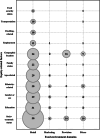Food environment research in Canada: a rapid review of methodologies and measures deployed between 2010 and 2021
- PMID: 38373957
- PMCID: PMC10875887
- DOI: 10.1186/s12966-024-01558-x
Food environment research in Canada: a rapid review of methodologies and measures deployed between 2010 and 2021
Abstract
Numerous research methodologies have been used to examine food environments. Existing reviews synthesizing food environment measures have examined a limited number of domains or settings and none have specifically targeted Canada. This rapid review aimed to 1) map research methodologies and measures that have been used to assess food environments; 2) examine what food environment dimensions and equity related-factors have been assessed; and 3) identify research gaps and priorities to guide future research. A systematic search of primary articles evaluating the Canadian food environment in a real-world setting was conducted. Publications in English or French published in peer-reviewed journals between January 1 2010 and June 17 2021 and indexed in Web of Science, CAB Abstracts and Ovid MEDLINE were considered. The search strategy adapted an internationally-adopted food environment monitoring framework covering 7 domains (Food Marketing; Labelling; Prices; Provision; Composition; Retail; and Trade and Investment). The final sample included 220 articles. Overall, Trade and Investment (1%, n = 2), Labelling (7%, n = 15) and, to a lesser extent, Prices (14%, n = 30) were the least studied domains in Canada. Among Provision articles, healthcare (2%, n = 1) settings were underrepresented compared to school (67%, n = 28) and recreation and sport (24%, n = 10) settings, as was the food service industry (14%, n = 6) compared to grocery stores (86%, n = 36) in the Composition domain. The study identified a vast selection of measures employed in Canada overall and within single domains. Equity-related factors were only examined in half of articles (n = 108), mostly related to Retail (n = 81). A number of gaps remain that prevent a holistic and systems-level analysis of food environments in Canada. As Canada continues to implement policies to improve the quality of food environments in order to improve dietary patterns, targeted research to address identified gaps and harmonize methods across studies will help evaluate policy impact over time.
Keywords: Food composition; Food environments, Monitoring, Research methodologies and measures, Food marketing, Food labelling; Food prices; Food provision; Food retail; Food trade and investment.
© 2024. The Author(s).
Conflict of interest statement
The authors declare that they have no competing interests.
Figures



Similar articles
-
Nutritional labelling for healthier food or non-alcoholic drink purchasing and consumption.Cochrane Database Syst Rev. 2018 Feb 27;2(2):CD009315. doi: 10.1002/14651858.CD009315.pub2. Cochrane Database Syst Rev. 2018. PMID: 29482264 Free PMC article.
-
What is the effectiveness of obesity related interventions at retail grocery stores and supermarkets? -a systematic review.BMC Public Health. 2016 Dec 28;16(1):1247. doi: 10.1186/s12889-016-3985-x. BMC Public Health. 2016. PMID: 28031046 Free PMC article.
-
Strategies for enhancing the implementation of school-based policies or practices targeting risk factors for chronic disease.Cochrane Database Syst Rev. 2017 Nov 29;11(11):CD011677. doi: 10.1002/14651858.CD011677.pub2. Cochrane Database Syst Rev. 2017. Update in: Cochrane Database Syst Rev. 2022 Aug 29;8:CD011677. doi: 10.1002/14651858.CD011677.pub3. PMID: 29185627 Free PMC article. Updated.
-
A systematic review, and meta-analyses, of the impact of health-related claims on dietary choices.Int J Behav Nutr Phys Act. 2017 Jul 11;14(1):93. doi: 10.1186/s12966-017-0548-1. Int J Behav Nutr Phys Act. 2017. PMID: 28697787 Free PMC article.
-
The effectiveness of interventions to meet family needs of critically ill patients in an adult intensive care unit: a systematic review update.JBI Database System Rev Implement Rep. 2016 Mar;14(3):181-234. doi: 10.11124/JBISRIR-2016-2477. JBI Database System Rev Implement Rep. 2016. PMID: 27532144
Cited by
-
Evaluating the Proportion of Foods and Beverages in the Canadian Grocery and Chain Restaurant Food Supply That Would Be Restricted from Marketing to Children on Television and Digital Media.Nutrients. 2025 May 28;17(11):1828. doi: 10.3390/nu17111828. Nutrients. 2025. PMID: 40507097 Free PMC article.
-
Twenty years of behavioral nutrition- A reflection on the road less travelled.Int J Behav Nutr Phys Act. 2025 Jul 25;22(1):104. doi: 10.1186/s12966-025-01804-w. Int J Behav Nutr Phys Act. 2025. PMID: 40713823 Free PMC article.
References
-
- World Health Organization . Report of the commission on ending childhood obesity. Geneva: World Health Organization; 2016.
-
- Downs SM, Ahmed S, Fanzo J, Herforth A. Food environment typology: advancing an expanded definition, framework, and methodological approach for improved characterization of wild, cultivated, and built food environments toward sustainable diets. Foods. 2020;9(4):532. doi: 10.3390/foods9040532. - DOI - PMC - PubMed
Publication types
MeSH terms
Grants and funding
LinkOut - more resources
Full Text Sources
Research Materials

